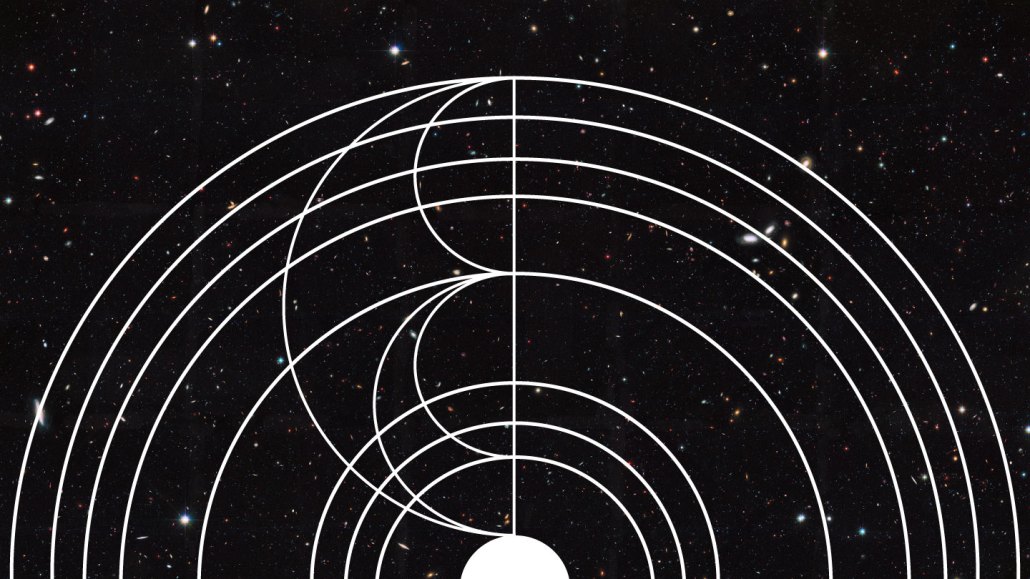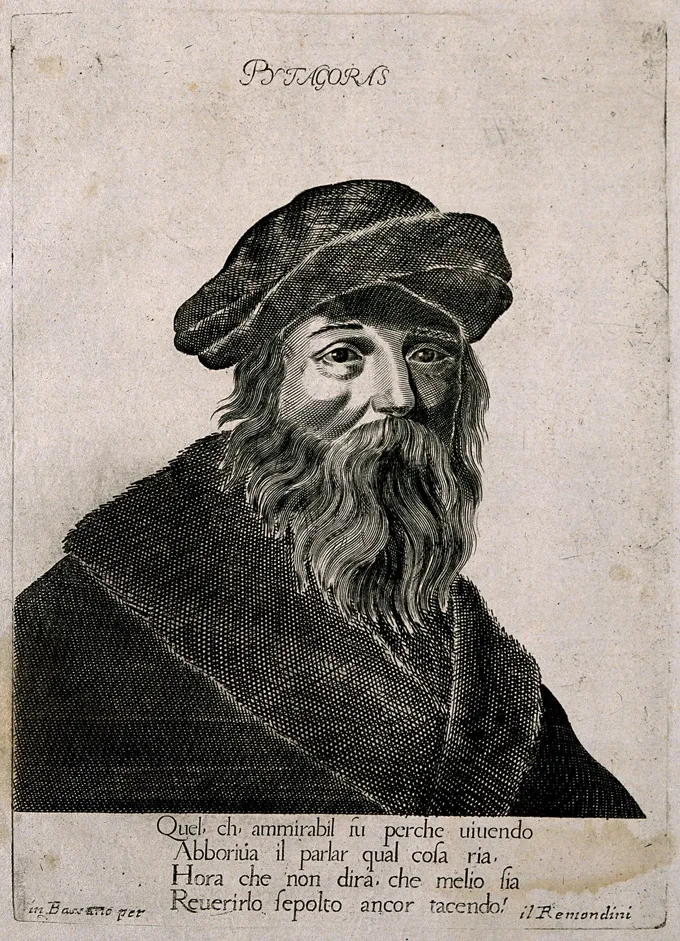
The Pythagoreans believed that the motions of the heavenly bodies, with just the right ratios of their distances from a central fire, made pleasant music — a concept that evolved into the “music of the spheres.”
NASA, ESA, the GOODS Team, and M. Giavalisco (University of Massachusetts, Amherst)/T. Tibbitts
If you’ve ever heard the phrase “the music of the spheres,” your first thought probably wasn’t about mathematics.
But in its historical origin, the music of the spheres actually was all about math. In fact, that phrase represents a watershed in the history of math’s relationship with science.
In its earliest forms, as practiced in ancient Egypt and Mesopotamia, math was mainly a practical tool for facilitating human interactions. Math was important for calculating the area of a farmer’s field, for keeping track of workers’ wages, for specifying the right amount of ingredients when making bread or beer. Nobody used math to investigate the nature of physical reality.
Not until ancient Greek philosophers began to seek scientific explanations for natural phenomena (without recourse to myths) did anybody bother to wonder how math would help. And the first of those Greeks to seriously put math to use for that purpose was the mysterious religious cult leader Pythagoras of Samos.
It was Pythagoras who turned math from a mere tool for practical purposes into the key to unlocking the mysteries of the universe. As the historian Geoffrey Lloyd noted, “The Pythagoreans were … the first theorists to have attempted deliberately to give the knowledge of nature a quantitative, mathematical foundation.”
Pythagoras was born in about 575 B.C. on Samos, an island in the Eastern Mediterranean near the coast of present-day Turkey. He traveled widely, to Egypt and Babylonia and perhaps even Persia, to learn how math was used in those ancient cultures. He may even have spent time in the city of Miletus (not far from Samos) to study with the aging Thales, the founder of the ancient Greek effort to explain the world rationally.
Around the age of 40 or so, Pythagoras headed west to southern Italy, settling in the Greek colony town of Croton. There he initiated a new phase of ancient science, mixing religion, music and math in a cult devoted to living in harmony with nature. For Pythagoras, the historian of Greek philosophy W.K.C. Guthrie wrote, philosophy ceases to be primarily about explaining nature but instead “becomes the search for a way of life whereby a right relationship might be established between the philosopher and the universe.”
Of course, if your goal is to live in harmony with the universe, you need to know something about the universe. So even though Pythagoras basically established a religious cult, he and his followers still expanded the Greek quest to explain the cosmos.
And that’s where math came in.
The universe is made from numbers
Pythagoras believed that, at its root, reality was made from numbers. That sounds crazy to modern minds taught that matter is made of atoms and molecules. But in ancient times, nobody really knew anything about what reality is. Every major philosopher had a favorite idea for what sort of substance served as reality’s foundation.
Thales, for instance, thought everything derived from water. His student Anaximander rebelled, arguing that reality at its root consisted of some infinite, featureless material called the apeiron, or the unlimited. Anaximenes, Anaximander’s successor, rejected the apeiron in favor of air — everything could be explained by air either rarefying or solidifying. A later philosopher, Heraclitus, insisted that everything ultimately came from fire.
Pythagoras chose numbers. Numbers, he taught his followers, are the seeds from which all reality grows. All members of the Pythagorean cult had to recite an oath crediting him with identifying the numbers “which contain the fount and root of ever-flowing nature.”
Specifically, Pythagoras identified the root of reality in what he called the tetractys, consisting of the first four integers: 1, 2, 3 and 4. Added together, those numbers equal 10. Ten, Pythagoras concluded, is the “perfect” number, the number that holds the key to understanding nature.
And why 1, 2, 3 and 4? Because those numbers were the key to creating harmonious sounds.
Imagine plucking a taut string of fixed length, producing a musical note. If you pluck a string half as long, you get another note, separated from the first note by an octave. If the strings are plucked simultaneously, the two notes are harmonious. In other words, a 2:1 ratio of string lengths produces a pleasing sound. In a similar way, other harmonious musical intervals called the fourth and the fifth represent string length ratios of 4:3 and 3:2. Pythagoras realized that these harmony-producing ratios all involved the numbers 1, 2, 3 and 4. Therefore, he concluded, their sum, 10, was the key number for developing a theory of the universe.

Pythagoras himself may not have developed that theory fully, but his later followers produced a vision of the universe consisting of heavenly bodies revolving around a “central fire.” That fire was NOT the sun, which was just one of the other heavenly bodies. The sun shone brightly because it reflected the light from the central fire back to the Earth (and the inhabited part of the Earth always faced away from the fire).
The Pythagoreans surmised that the motions of the heavenly bodies generated pleasant music. As Aristotle later explained it, those bodies move rapidly and therefore they must make sound, because anything moving quickly on Earth makes sound (think arrows whizzing through the air). Proper ratios of the planets’ speeds (which depended on their distances from the central fire) guaranteed that the sounds would be harmonious. Hence the moving planets created a “harmony of the heavens.” Because later Greek writers supposed that each planet is carried on its orbit by a rotating sphere, eventually that harmony became known as “the music of the spheres.”
The universe is a musical instrument
So in a sense, the Pythagoreans believed that the universe itself could be regarded as a gigantic musical instrument. As Aristotle put it, the Pythagoreans thought “the whole heaven to be a musical scale and number.”
But this picture had a problem. The Pythagoreans knew of only eight heavenly bodies: Earth, moon, sun, Mercury, Venus, Mars, Jupiter and Saturn. A ninth, outermost sphere transported the fixed stars. But to be perfect, the cosmos needed a 10th body. So the Pythagoreans proposed the existence of another planet, a “counter-Earth,” orbiting the central fire inside the orbit of the Earth. Nobody could see that planet because it was always on the other side of the fire. Rather than limit their description of the cosmos to what could be observed, the Pythagoreans resorted to mathematical theory to infer the existence of an unseen reality.
This theory was wrong, of course. But it nevertheless foreshadowed the modern use of mathematics to predict unseen phenomena. In the 19th century, for instance, James Clerk Maxwell used equations to predict the existence of radio waves. In the 20th century, Paul Dirac used math to predict the existence of antimatter. And in the 21st century, astronomers detected gravitational waves, vibrating space itself, as physicists had expected based on the math of Einstein’s general theory of relativity.
Using math for understanding nature was unknown before Pythagoras. It was his idea. Previously math had been a tool for scribes or surveyors or cooks. “Pythagoras freed mathematics from these practical applications,” the Dutch mathematician B.L. van der Waerden wrote in his classic history of ancient math. “The Pythagoreans pursued mathematics as a kind of religious contemplation, as a way to approach the eternal Truth.”
As for the music of the spheres, one issue remained. If the heavens made harmonious sounds, why didn’t anybody hear them? Aristotle reported that the Pythagoreans “explain this by saying that the sound is in our ears from the very moment of birth and is thus indistinguishable from its contrary silence.”
Aristotle rejected that explanation, just as he rejected the idea of a “counter-Earth” as well as the whole notion that everything was made from numbers. And yet, the importance of numbers in science, first expressed by Pythagoras, ultimately proved to be much more resilient than most of Aristotle’s ideas. As experts on early Greek philosophy André Laks and Glenn Most have written, “Of all the early Greek philosophers,” Pythagoras “without a doubt exerted the longest-lasting influence until the beginning of modern times.”







